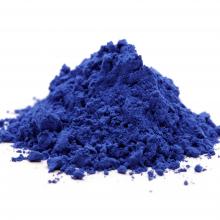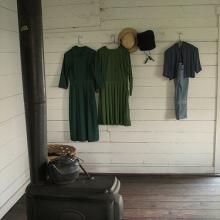clothing
WHEN BSHARA NASSAR moved to the United States in 2011, he quickly noticed that something was missing. “There was no place for our story to be told,” said Nassar, a Palestinian Christian born in Jerusalem and raised in Bethlehem. (“My family has been Christian for 2,000 years,” Nassar told Sojourners. “We didn’t convert — the faith was born here!”) But he felt the story of the Palestinian people “was always being distorted or minimized — it was always about either ‘victims’ or ‘violence.’” So, in 2015, Nassar started visiting universities, churches, and community centers with a “traveling exhibit” of only two pieces, focused on refugees from Palestine. “It took a while to build momentum,” Nassar said.
Nassar is now director of the Museum of the Palestinian People, situated in a rowhouse near Dupont Circle in Washington, D.C. Through the museum, Nassar said, “We want to share our story from our perspective — who we are, where we come from. For too long our stories have been told by others, who portray us in often negative stereotypes. We want to share with the world who Palestinians truly are.”
The museum’s latest exhibition focuses on tatreez, the art of Palestinian embroidery, and looks at the role of “material culture and art history in preserving a nation’s identity,” according to exhibit curator Wafa Ghnaim. For Ghnaim, the first Palestinian embroidery instructor at the Smithsonian Museum and now a senior research fellow for the Metropolitan Museum of Art, the exhibit is about addressing the question, “How do we reclaim our heritage?” The exhibit includes embroidered dresses from before and after 1948—the year of what Palestinians call the Nakba, or catastrophe, when according to the Institute for Palestine Studies, two-thirds of the Palestinian population was uprooted as the State of Israel was created. “The dresses created before 1948 reflect a village identity,” Ghnaim, an expert in Palestinian traditional dress, told Sojourners, “while dresses created after 1948 reflect a national identity.”
Sustainable fashion is a rapidly growing movement. Honoring the labor, expertise, and material resources used to make clothes is also an essential way for people of faith to honor God. So how do we do that effectively? Thankfully, the solution starts no further than your closet. Here are five ways to dive in and begin embodying Christ’s righteousness in your relationship to your clothes.
Because for her, designing clothes for Muslim women is less about a modest fit and more about carrying out an Islamic ethic. Of course, it’s also about style. “The modest fashion industry didn’t have anything that was speaking to the fashion-forward and edgy Muslim girl,” Ijaz says. “They’re all speaking to a person that I would see as my mom or my aunt.”

Image via Abel Tumik/Shutterstock.com
The complex history of indigo reveals how little we know, or remember, about how our clothes are made. It’s not a new problem, but it’s still very much a problem — our world is more connected than ever before but, paradoxically, international supply chains are increasingly complex and we feel more disconnected than ever from the impact our lives have on others.
Radical Muslims. The phrase elicits images of ISIS militants and terror in the desert, perhaps grainy YouTube videos, Kalashnikovs, and raised fists.
What about a man in an ankle-length garment and cotton headscarf carving the air with his skateboard?
Is that a radical Muslim?
Along with shirts bearing the “Radical Muslims” image and a Nike-like swoosh saying “Just Dua It” (dua being nonobligatory Muslim prayer, or supplications), Boston-based Munir Hassan has created an entire line of stereotype-shattering clothing for American Muslims.
In an explicit attempt to flip the script on popular images of Muslims and Islamic symbols, Hassan’s own Sidikii Clothing Co. merges cultures in fashion-forward, Muslim inspired designs.
“I’m Muslim, I’m American. I was born both,” said Hassan.
“I wanted to design clothing that showcased different pieces of my culture inclusively.”
When Mormon leaders sense a decline of moral standards in the world, they roll out sermons on modesty.
In the 1960s and early ’70s, they preached against miniskirts and hot pants; in today’s sex-drenched society, it’s spaghetti straps, bare midriffs, and skinny jeans.
It’s often couched in the rhetoric of “virtue” and usually aimed at young women, even girls.

Amish farmhouse, clothes. Image via http://bit.ly/zy2VYJ
They were pedaling the latest fashions before you even knew they even existed. They wear anything with a sense of effortless cool. They… still ride horse and carts.
Wait, what?




